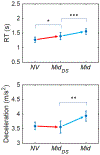The effects of simulated acuity and contrast sensitivity impairments on detection of pedestrian hazards in a driving simulator
- PMID: 31983886
- PMCID: PMC6980428
- DOI: 10.1016/j.trf.2019.05.003
The effects of simulated acuity and contrast sensitivity impairments on detection of pedestrian hazards in a driving simulator
Abstract
Driving is a highly visual task, yet the vision requirements for driving licensure vary widely. All US states have a threshold for visual acuity (e.g. most use 20/40 for an unrestricted license). Contrast sensitivity (CS) is not measured for licensure, despite evidence that it may be a better predictor of crash risk than visual acuity (VA). Two experiments were conducted to investigate how simulated reductions in VA and CS affect the detection of pedestrians in a driving simulator during the daytime in a highway setting. Young normally-sighted current drivers wore goggles simulating different levels of VA and CS loss (within a range that would meet licensing criteria) and pressed the horn as soon as they saw a pedestrian. The proportion of pedestrians detected and driving speed was not different between the conditions. Reducing VA alone did not significantly reduce reaction time or the deceleration needed to stop before the collision point. However, adding a CS loss to a VA deficit increased both reaction time and the deceleration required to stop before the collision point. These results suggest that an individual's CS should be considered when determining visual fitness to drive, especially in the early stages of ocular disease, such as cataract, where CS may be impaired while high contrast VA is still relatively unimpaired.
Keywords: driving simulation; hazard detection; simulated vision impairment.
Figures









References
Grants and funding
LinkOut - more resources
Full Text Sources
